Credit: Airbus Defence and Space
ESA's Cheops satellite – seen here at Airbus in Madrid – will measure the sizes of known exoplanets by detecting tiny fluctuations in the light of their parent stars. Due to be ready for launch at the end of this year, Cheops, or 'CHaracterising ExOPlanet Satellite' is only 1.5 m by 1.4 m by 1.5 m in size. It weighs in at about 300 kg fully fuelled – less than a large motorbike.
Small satellites as a term covers everything from this sub-tonne class of mission, down to CubeSats and picosats. Their ever-growing capabilities is under discussion at this week's 4S Small Satellite Systems and Services Symposium in Sorrento, Italy. Organised by ESA's Head of Optics, Luca Maresi, the symposium's speakers include Roger Walker, who leads ESA's Technology CubeSat efforts on sending small satellites beyond Earth orbit.
Provided by European Space Agency
























